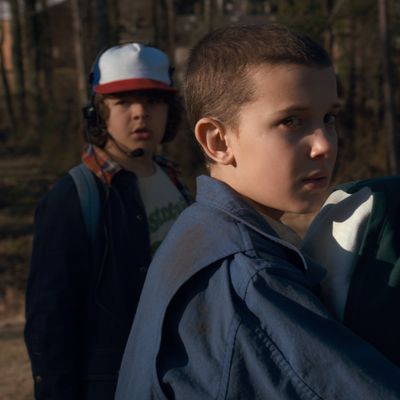
In 1984, the year after Stranger Things takes place, Hollywood’s summer hit streak of Ghostbusters, Gremlins, and The Karate Kid took an anticlimactic turn. That July, The Last Starfighter tried and failed to seize the imaginations of audiences looking for the next Star Wars. The film is entertainingly tacky, but it’s notable mainly for a premise that tapped into a primal nerd fantasy: All the dorky, time-wasting pursuits occupying a nerd’s life will someday be useful in saving the universe. In The Last Starfighter, the Chosen One–type is so chosen because he’s excellent at an arcade game used as a recruiting tool for interstellar warfare. Ernest Cline’s junky novel Ready Player One — soon to be a Steven Spielberg film — goes even further, setting up a virtual realm that its hero navigates through his vast knowledge of pop history.
Stranger Things isn’t quite as shameless, but its heavy reliance on ‘80s reference points makes it feel like a product of (and gift to) fan culture, one big homage to the movies that the Duffer brothers love. And that extends to the characters, too, even though they can’t know how much they’re playing out a script that the culture has already written. In “The Flea and the Acrobat,” the show goes one step further by connecting the parallel netherworld of its faceless creature with “The Vale of Shadows,” a Dungeons & Dragons realm that acts as a dark reflection or echo of our own world. (“It’s right next to you and you don’t even see it.”) In true Last Starfighter spirit, a group of picked-on nerds are finally able to use their store of RPG arcana as applied knowledge. D&D is now IRL.
The nerds in question — Mike, Lucas, Dustin, and their volatile new friend, Elle — figure out that Will has been abducted to a world not their own, so they spend the better part of this episode trying to figure out how to access it. Their mission takes them first to their science teacher, who offers the title metaphor: an acrobat that can only move back and forth across a tightrope and a flea that can go underneath and upside down. That metaphor is dropped quickly for the more useful information that a “massive amount of energy” would be required to open up a tear in space-time and that such a gate may already exist. Then Dustin comes to the realization that their compasses — like good Boy Scout adventurers, they each have one — are not pointed true north, which means that a more powerful magnetic field is exerting itself. That leads them on a journey that’s sabotaged by a third, even more powerful force, in the form of Elle, who concludes, quite reasonably, that three pre-teen boys with compasses (and a slingshot) are not adequate for the fight ahead. They know how to find their Vale of Shadows, but can’t enter without a fireball.
Nancy and Jonathan are better prepared. Jonathan lifts a handgun out of his dad’s car and after a few stray rounds of target practice, they head off into the woods in a blind search for Barb and Will. Nancy’s still on the outs with Steve, but that doesn’t stop Jonathan from needling her about their relationship. She knows Steve isn’t a great guy — his attempts at an apology are undermined by his vain preening as a pompadoured Tom Cruise — but she bristles at Jonathan’s attempt at armchair analysis. He believes that his camera gives him insight into how people really feel, but in reading Nancy as “lonely” in her state of half-dress in Steve’s bedroom, his interpretation looks as much like projection as truth. Jonathan has feelings for her, so of course she looks miserable with a guy he can’t stand and of course she seems like a “suburban girl who thinks she’s rebelling.” There’s some truth in what he says, but his jealousy and passive-aggression are just as plain a truth to Nancy.
“I don’t think my parents ever loved each other,” Nancy confesses earlier in their walk, and with that, another unifying theme comes to the surface: All the major characters come from broken homes. Nancy and Mike’s parents are still together, but it’s plain even to their children that their marriage isn’t working. (Perhaps this explains, to some extent, why she’s so desperate for them to talk to her.) We already know that Joyce and her boys are scraping and clawing to keep their household together with Lonnie out of the picture. And in this episode, we learn that his return has nothing to do with supporting the family. He merely wants to pursue a wrongful death lawsuit against the quarry for improper fencing. Information also trickles out about Hopper’s daughter, his ex-wife, and the personal tragedy that both burdens him and motivates him in the search for other lost children.
That’s the series’ deepest connection with E.T., perhaps the most-referenced ‘80s film on a show littered with references. Spielberg may have idealized suburbia in E.T., but it was also a place of chaos and disorder, a place of nuclear families blown up. Like Mary in E.T., Joyce doesn’t have the luxury to keep her eyes on her children all the time. This teaches them independence, but also leaves them vulnerable to danger. Yet there’s also the sense that the day-to-day fight brings them closer together as a unit, because they need each other to get by. And out of these these broken families — Joyce’s, Hopper’s, and Mike and Nancy’s — come new bonds to make them whole.
Demogorgons:
- The excellent faux-Carpenter synth score of the credits is used sparingly on the show itself, but its eerie pulse works well when it’s deployed on suspense sequences like Hopper’s infiltration of the lab.
- Would Jonathan have a poster for The Evil Dead in his room? He’d have to be a pretty hip weirdo to make it happen, given the slow trickle of cult appreciation that followed the film’s original release in 1981. Not quite as unlikely as Kristen Stewart’s character in Adventureland owning Big Star’s “Radio City” on vinyl, but a stretch.
- Dustin, after Lucas lets loose with an “Are we there yet?” whine: “These only tell directions, not distances. You really need to learn more about compasses.”
- The episode’s other big revelation is the origin of the faceless creature, which seems triggered by Elle’s psychic mission to investigate a Soviet spy. The all-black realm where Elle does her work also brings the sci-fi references more up to date, recalling Scarlett Johansson’s alien lair in Under the Skin.
- Credit the show for choosing a deeper-than-expected Echo and the Bunnymen cut for the closing credits. The album Ocean Rain produced “Killing Moon,” perhaps its most famous song, but “Nocturnal Me” wasn’t even a single.


